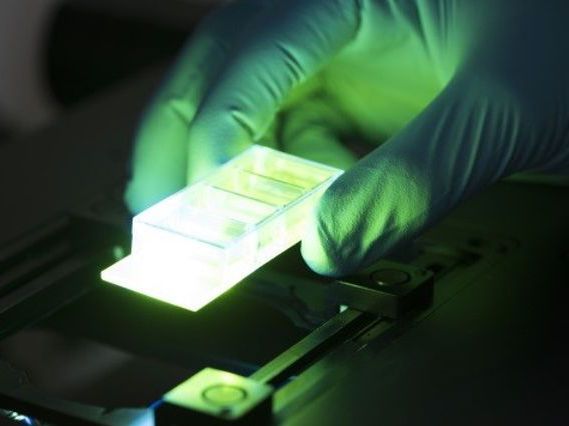Detecting pathogens using quantum technology
Advertisement
Safe diagnoses of diseases, identification of multidrug-resistant germs, detection of beginning epidemics at an early stage or detection of toxins and pathogens in drinking water and food in even the lowest concentrations – these are major challenges and goals of current research programs. One of the most promising tools for these tasks are novel and considerably improved biosensors. The project “BioSensing” of the Fraunhofer Institutes for Silicate Research ISC and for Molecular Biology and Applied Ecology IME and the Leiden University, Institute of Physics aims to overcome the limits of modern biosensors with the help of quantum technology.

DNA-stabilized metal quantum clusters belong to a novel class of biological nanomaterials and, in the future, could be used as highly sensitive, cost-effective biosensors. With their fluorescence properties researchers could detect diseases quickly and reliably
© Fraunhofer ISC
Medical diagnoses could be even more reliable and efficient with the use of biosensors, but researchers face great challenges. The sensors should be sufficiently sensitive to detect even the smallest amounts of pathogens in the blood or other biological fluids. At the same time, they should be able to identify even difficult-to-diagnose diseases in real time so that effective therapy procedures can start at an early stage.
These tasks are to be mastered with novel biosensors based on quantum effects in the project “BioSensing”, funded within the framework of the Fraunhofer program “ICON”. The project focuses on a novel class of biological nanomaterials, so-called DNA-stabilized metal quantum clusters (QC-DNA), which are used as “quantum biosensors”. In their simplest form, these biosensors consist of a short DNA sequence that encloses a group of six to fifteen metal atoms called metal cluster. The choice of DNA sequence determines the sensor characteristics and which disease is detected. The basic structure of a quantum biosensor can be extended by additional specific biomolecules and thus be used for the detection of selected biomarkers.
But how do researchers recognize that a quantum biosensor has detected a specific disease? They use the fluorescence properties of the metal cluster. If a successful detection has taken place, the wavelength of the light emitted by the metal clusters changes. QC-DNA are suitable for the development of highly sensitive sensors in biological systems and provide solutions for an advanced, intelligent and affordable therapy.
But such a quantum biosensor not only responds to diseases (caused by germs or even mutations in the genome), but also to changing environmental conditions, such as an increase of salt concentrations. Further applications are possible such as the monitoring of food and forage or the use in environmental analysis. A significant advantage is the cost-effective production of quantum biosensors.
So far, tests were limited to the lab, but the project partners of Fraunhofer ISC, IME and Leiden University in the Netherlands have set themselves the goal of designing various quantum biosensors, scaling them up to pilot scale and preparing them for feasibility studies in university hospitals.
In follow-up projects, the partners plan to develop a portable read-out device that works cost-effectively, highly sensitively, quickly and reliably and detects various pathogens, toxins or cancer cells.
Other news from the department science
These products might interest you
Most read news
More news from our other portals
See the theme worlds for related content
Topic world Diagnostics
Diagnostics is at the heart of modern medicine and forms a crucial interface between research and patient care in the biotech and pharmaceutical industries. It not only enables early detection and monitoring of disease, but also plays a central role in individualized medicine by enabling targeted therapies based on an individual's genetic and molecular signature.

Topic world Diagnostics
Diagnostics is at the heart of modern medicine and forms a crucial interface between research and patient care in the biotech and pharmaceutical industries. It not only enables early detection and monitoring of disease, but also plays a central role in individualized medicine by enabling targeted therapies based on an individual's genetic and molecular signature.


























































